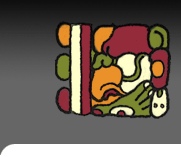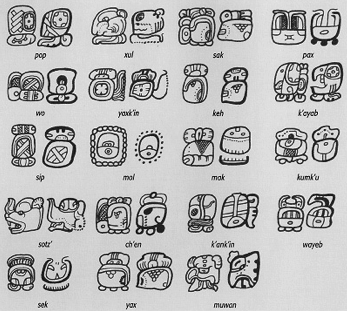 |
 |
 |

The Haab, or "vague" year, is the one most similar to the Christian calendar. With 365 days in its count, it is obviously based on solar observations. It's called the "vague" year because, unlike the Christian calendar, it does not include a leap year. The Haab was in use by at least 100 BC and was created to be used in conjunction with the Tzolk'in.

The Eighteen months of the Haab (Image adapted from Voss 2000) The Haab is made up of 18 months of 20 days each and a final short month of only 5 days. Together they form the 365-day, solar-based year. As with the Tzolk'in, each day is represented by a number-glyph combination, but the numbers are now 20, one for each day of a 20 day month. The first number of any given month is mathematically in the place of zero (a concept with which the Maya were aware), but written hieroglyphically as "seating." The patron deity of the month assumes the throne on day zero and stays for the next 19 days. The final five days of the Haab cycle are the 19th month, called Wayeb. These are unpredictable days, not for planning important events or traveling away from home. Despite the fact that a tourist can buy a charm with their "Maya month sign" in most of the publicly accessible ruins as if they were related to the concept of Greek zodiacal signs, the modern Maya assign no horoscope-like significance to these signs. It is the 260-day Tzolk'in, not the Haab that informs one of their personality traits and destiny. Contact period documents, especially the writings of Diego de Landa, do relate the existence of a festival cycle that followed the Haab. The following is translation of each month name and a brief list of what was to be celebrated during each: Pop - Mat (symbol of community and marriage) The first month of the year, preceded by fasting and abstinence. On the first day of the year there was gift giving and drinking. Uo - Frog Physicians and shamans made offerings to Itzamna, the god of magic and patron of priests. Predictions for the year were made and individual priests were assigned their festival obligations for the year. Zip - Red -- (perhaps red conjunction?) A month to honor the god of hunting, Ek Zip. Hunters and fisherman blessed their tools and performed blood letting ceremonies. Zotz - Bat Bee keepers prepared themselves for the coming activities by fasting. It may have also been associated with the beginning of the darkest months of the year in fall. Tzec - no known translation The bee keeper festival occurred. Offerings were made to images of the four Chaaks (rain gods), and the rims of offering plates were covered in honey. Hive owners shared honey with the community. Xul - Dog The festival of Chicc-kaban, dedicated to Kulkulcan, the Feather Serpent. It was marked by processions to primary community temples, accompanied by troupes of comedians. Offerings were made at the temple and much incense was burned. The comedians continued to visit neighborhoods throughout the month, performing and bringing offerings back to the temple. At the end of the month, Kulkulcan was said to descend from the the heavens and collect the offerings. Yaxkin - First (or Green) Sun Preparations for the festivals during the next month. Instruments were anointed and many items were painted blue. Children were all given nine light raps on their knuckles to assure they would become skilled craftsmen like their parents. Mol - Water or Jade A month to make wooden effigies of the gods. Wood was chosen with care and carving was done with ceremony and blood letting. Carvers worked continuously, their families bringing them food and water, until the images were complete. Chen - Cave or Well The wooden effigies they had made the month before were delivered to shrines and valuable offerings were made to them as a way of "activating" them. Afterwards, the artisans were honored by feasting and drinking. In glyphs, the patron of this month is the Moon Goddess. Yax - Green or First The temples were renovated or repaired as needed. Ceremonies honoring Chaak the rain god and prayers for the maize fields were performed. In glyphs, the patron of this month is Venus. Zac - White The hunters had their second festival of the year, this one to ask for the forgiveness of the gods for shedding the blood of animals. Keh - Red (or perhaps Deer) No specific festival is recorded for this month, though some scholars believe it may have been connected to ceremonies honoring deer. Mac - To Enclose, to Cover Ceremonies led by the elders of the community honored Chaak and Itzamna. Fires were lit atop the temples and the hearts of birds and animals were thrown into the flames. When they were completely burned, a bucket of water was poured on them as if rain from Chaak had extinguished them. Kankin - Yellow Sun No festival is recorded for this month. J. Eric Thompson believed that the glyph Kankin represents the rib cage of a dog, and that this month was somehow associated with canines. Muwan - The Moan Bird (relative of the owl) During this month the owners of cacao plantations gave thanks to the gods who protected their trees. Dogs and blue iguanas were sacrificed in the groves and each of the officers was given a cacao branch. Pax - Planting Time This month was filled with ceremonies honoring warriors. Community members escorted the war chief to the temple and feasts and dances were conducted in his honor. Dogs were sacrificed and prayers for victory in future battles were made. Kayab - Turtle There are no recorded festivals associated with this month. Glyph associations point to the young Moon Goddess as the patron and perhaps ceremonies honoring child birth and midwives were conducted. Kumku - Ripe Maize No festivals are recorded for this month, but its name suggests harvest ceremonies occurred. Wayeb - Misfortunate or Nameless Days Considered bad luck days, during which one should do nothing of significance. Many would neither bath nor leave their houses. No activities were planned, less something evil befall them. |


